The Converted Flexible Packaging Market is estimated to be valued at USD 331.6 billion in 2025 and is projected to reach USD 524.9 billion by 2035, registering a compound annual growth rate (CAGR) of 4.7% over the forecast period.
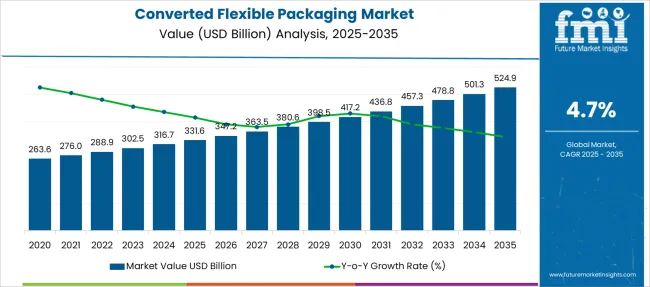
| Metric | Value |
|---|---|
| Converted Flexible Packaging Market Estimated Value in (2025 E) | USD 331.6 billion |
| Converted Flexible Packaging Market Forecast Value in (2035 F) | USD 524.9 billion |
| Forecast CAGR (2025 to 2035) | 4.7% |
The converted flexible packaging market is experiencing sustained growth owing to rising demand for lightweight, cost effective, and sustainable packaging formats across a range of industries. The shift in consumer preference toward convenience products and the rise of e commerce have accelerated the use of flexible solutions that offer extended shelf life and easy handling.
Technological innovations in film barrier properties, resealable closures, and digital printing have enabled enhanced branding and functional performance. Regulatory emphasis on reducing packaging waste and improving recyclability is further encouraging the transition from rigid to flexible formats.
As manufacturers and retailers seek to optimize supply chain efficiency while meeting sustainability benchmarks, converted flexible packaging continues to gain relevance across food, beverage, pharmaceutical, and personal care sectors.
The market is segmented by Material, Product Type, and End Use and region. By Material, the market is divided into Plastic, Paper, and Metal (Foil). In terms of Product Type, the market is classified into Bags & Sacks, Pouches, Sachets & Stick Packs, Tapes, Labels, Tubes, and Liners. Based on End Use, the market is segmented into Food & Beverage, Healthcare, Cosmetics & Personal Care, Electronical & Electronics, Agriculture, Building & Construction, and Other Consumer Goods. Regionally, the market is classified into North America, Latin America, Western Europe, Eastern Europe, Balkan & Baltic Countries, Russia & Belarus, Central Asia, East Asia, South Asia & Pacific, and the Middle East & Africa.
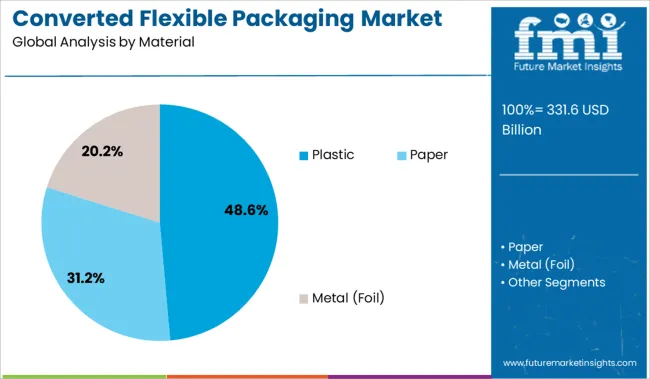
The plastic material segment is projected to contribute 48.60% of the total market revenue by 2025, establishing it as the leading material category. This dominance is driven by its versatility, durability, and ability to offer strong barrier properties against moisture, oxygen, and contaminants.
Plastic materials also support advanced printing and lamination techniques, which enhance shelf appeal and brand visibility. In addition, the cost efficiency and mechanical strength of plastic allow for thinner packaging with improved performance.
As regulatory frameworks evolve, the development of recyclable and bio based plastics is supporting continued use within sustainable packaging strategies. These factors have reinforced the material's widespread adoption and sustained leadership in the converted flexible packaging market.
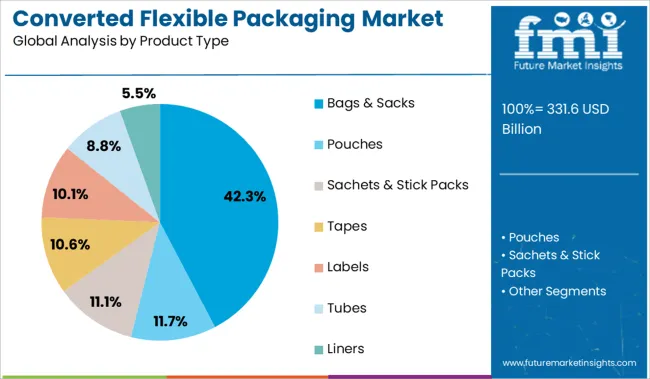
The bags and sacks segment is expected to account for 42.30% of total revenue by 2025 within the product type category. This is attributed to its broad usage across various end use sectors such as retail, agriculture, and consumer goods.
The segment is favored for its adaptability in size and structure, as well as ease of transportation and storage. Bags and sacks offer excellent flexibility in sealing, branding, and product visibility, making them a preferred option for both bulk and single use packaging.
The format also aligns well with sustainability initiatives due to its compatibility with recyclable and mono material structures. These advantages have strengthened the dominance of this product type in the market.
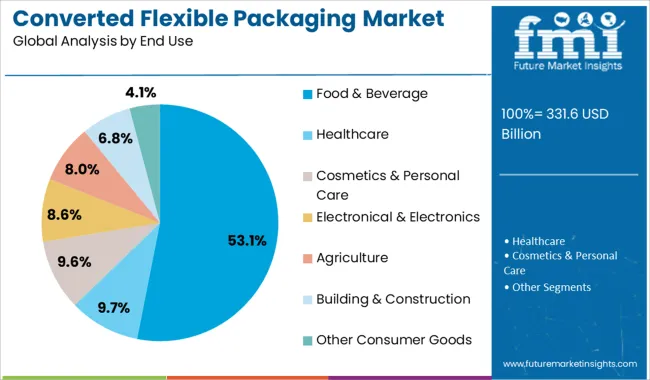
The food and beverage segment is anticipated to hold 53.10% of total market revenue by 2025, emerging as the largest end use category. This is fueled by rising demand for on the go and ready to eat food products, where packaging must ensure freshness, safety, and visual appeal.
Converted flexible packaging formats support vacuum sealing, portion control, and extended shelf life, which are critical in food preservation and consumer convenience. The segment also benefits from regulatory compliance and safety certification standards that flexible packaging materials can meet effectively.
With continued innovation in barrier technologies and sustainable packaging materials, the food and beverage industry remains the primary driver of growth in the converted flexible packaging market.
The global converted flexible packaging market expanded at a CAGR of 3.8% during the historic period and reached USD 331.6 billion in 2025.
The global rise in demand for user-friendly packaging solutions results in higher demand for converted flexible packaging solutions, as consumers are stimulated to buy convenient packaging solutions over other alternatives. The outcome of the growing popularity of converted flexible packaging solutions is a sharp rise in sales of plastic packaging solutions for packing their products & offerings by various end-user industries.
As compared to other rigid packaging solutions used for packaging food & beverages, pharmaceutical goods, personal care & cosmetics products, the usage of converted flexible packaging solutions for the same goods results in increased shelf lives of the product. End-user industries can cater to advanced market needs of delivering products such as foods, vegetables, and seafood, by keeping the freshness of the product intact.
The converted flexible packaging solutions such as pouches, sachets, and bags in comparison to rigid clamshells, trays, and boxes maintain the freshness of the product and keep it free from external moisture and harsh atmospheric repercussions. Above mentioned factors drive the demand for converted flexible packaging solutions across all parts of the world and result in the future growth of the global converted flexible packaging market.
The impressive rise in the food & beverages market in recent years has forced key market players in the packaging industry to come up with distinctive packaging solutions that cater to the needs of present-day consumer demands. Recent studies have indicated a rise in easy-to-carry packaging for food & beverage products; consumers choose products with packaging that allows them to enjoy their product in their most suitable way and time.
Therefore, according to recent consumer preferences, buyer is willing to pay more for the latest packaging solution, which solves the problems they used to face from traditional rigid packaging solutions.
So, modern-day producers are designing flexible packaging solutions that are specifically made for advanced food and beverage products. Recent developments and expansion of the pharmaceutical industry have also led to the growing demand for a flexible plastic packaging solution, which provides pharmaceutical drugs and equipment against the risk of contamination.
The converted flexible packaging pouches and bags have emerged as tested packaging solutions for the packing of different medical supplies and other drugs.
Based on product type, the pouches segment followed by the bags & sacks segment is estimated to hold around 58% of the market value share by the end of 2025. The reason behind the same is the increasing adoption of easy-to-use flexible packaging solutions by the end-use industries to augment the sales of pouches and bags & sacks.
The food & beverage segment by end use is projected to grow 1.7 times the current market value from 2025 to 2035. The surge in demand for convenient packaging solutions among food & beverage brands along with increased consumption of packed & ready-to-eat food products propel the demand for easy-to-handle and easy-to-carry packaging solutions. This is expected to offer productive growth opportunities for the global converted flexible packaging market.
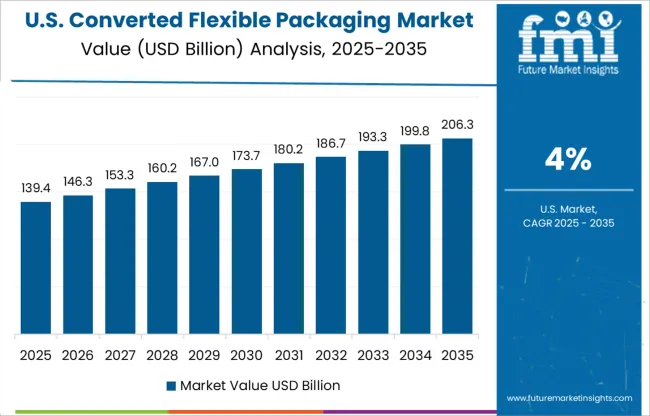
The majority of the North American converted flexible packaging market is projected to hold by the USA The USA-converted flexible packaging market is anticipated to register a CAGR of 4.4% from 2025 to 2035.
The USA is anticipated to augment the sales of converted flexible packaging due to the growing food industry as well as per capita spending on food rising in the USA According to the USA Department of Agriculture (USDA), in 2024 food stands in the third position in terms of the expenditures of the average USA household.
India is projected to hold around 48% by the end of 2035 and is estimated to expand 1.9 times the current market value during the forecast period. The largely rural population in India is the major factor creating a growth opportunity for small packs such as sachets & stick packs in India as these flexible small packaging packs with low prices & less quantity are best suitable for these populations to purchase.
According to the World Bank, around 65% of the total population in India was the rural population in 2024. Thus, the high rural population in India will create a growth opportunity for the converted flexible packaging market.
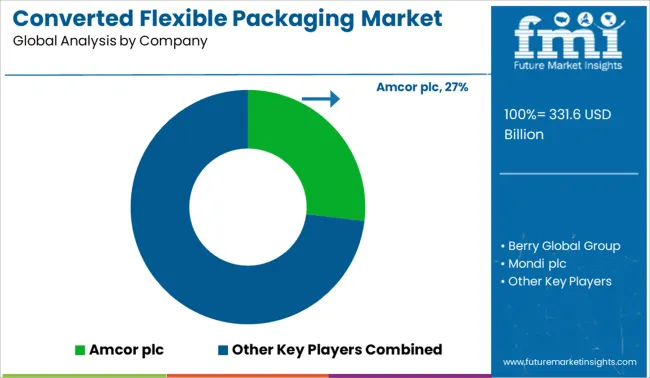
With the presence of various local and regional competitors in the market, the global stick packaging market is highly competitive. Key players are focusing on various different strategies to increase their revenue and market share in the converted flexible packaging market such as capacity expansion, mergers & acquisitions, expansions, collaborations, and partnerships. Some of the recent developments in the market are as follows -
| Attribute | Details |
|---|---|
| Growth Rate | CAGR of 4.7% from 2025 to 2035 |
| Base Year for Estimation | 2025 |
| Historical Data | 2020 to 2024 |
| Forecast Period | 2025 to 2035 |
| Quantitative Units | Revenue in USD Million, Volume in Tonnes and CAGR from 2025 to 2035 |
| Report Coverage | Revenue Forecast, Volume Forecast, Company Ranking, Competitive Landscape, Growth Factors, Trends and Pricing Analysis |
| Segments Covered | Material, Product Type, End Use |
| Regions Covered | North America; Latin America; Europe; East Asia; South Asia; Middle East and Africa (MEA); Oceania |
| Key Countries Covered | The USA, Canada, Mexico, Brazil, Germany, United Kingdom, France, Italy, Spain, Russia, China, Japan, India, GCC countries, Australia |
| Key Companies Profiled | Amcor plc; Berry Global Group; Mondi plc; Constantia Flexibles; Sonoco Products Company; Sealed Air Corporation; ProAmpac LLC; Huhtamaki Oyj; Adapa Group; Coveris Holding S.A.; Uflex Ltd.; Bischof + Klein SE & Co. KG; Winpak Ltd.; Glenroy, Inc.; InterFlex Group |
| Customization & Pricing | Available upon Request |
The global converted flexible packaging market is estimated to be valued at USD 331.6 billion in 2025.
The market size for the converted flexible packaging market is projected to reach USD 524.9 billion by 2035.
The converted flexible packaging market is expected to grow at a 4.7% CAGR between 2025 and 2035.
The key product types in converted flexible packaging market are plastic, _synthetic polymers, _bio-based polymers, paper and metal (foil).
In terms of product type, bags & sacks segment to command 42.3% share in the converted flexible packaging market in 2025.






Our Research Products

The "Full Research Suite" delivers actionable market intel, deep dives on markets or technologies, so clients act faster, cut risk, and unlock growth.

The Leaderboard benchmarks and ranks top vendors, classifying them as Established Leaders, Leading Challengers, or Disruptors & Challengers.

Locates where complements amplify value and substitutes erode it, forecasting net impact by horizon

We deliver granular, decision-grade intel: market sizing, 5-year forecasts, pricing, adoption, usage, revenue, and operational KPIs—plus competitor tracking, regulation, and value chains—across 60 countries broadly.

Spot the shifts before they hit your P&L. We track inflection points, adoption curves, pricing moves, and ecosystem plays to show where demand is heading, why it is changing, and what to do next across high-growth markets and disruptive tech

Real-time reads of user behavior. We track shifting priorities, perceptions of today’s and next-gen services, and provider experience, then pace how fast tech moves from trial to adoption, blending buyer, consumer, and channel inputs with social signals (#WhySwitch, #UX).

Partner with our analyst team to build a custom report designed around your business priorities. From analysing market trends to assessing competitors or crafting bespoke datasets, we tailor insights to your needs.
Supplier Intelligence
Discovery & Profiling
Capacity & Footprint
Performance & Risk
Compliance & Governance
Commercial Readiness
Who Supplies Whom
Scorecards & Shortlists
Playbooks & Docs
Category Intelligence
Definition & Scope
Demand & Use Cases
Cost Drivers
Market Structure
Supply Chain Map
Trade & Policy
Operating Norms
Deliverables
Buyer Intelligence
Account Basics
Spend & Scope
Procurement Model
Vendor Requirements
Terms & Policies
Entry Strategy
Pain Points & Triggers
Outputs
Pricing Analysis
Benchmarks
Trends
Should-Cost
Indexation
Landed Cost
Commercial Terms
Deliverables
Brand Analysis
Positioning & Value Prop
Share & Presence
Customer Evidence
Go-to-Market
Digital & Reputation
Compliance & Trust
KPIs & Gaps
Outputs
Full Research Suite comprises of:
Market outlook & trends analysis
Interviews & case studies
Strategic recommendations
Vendor profiles & capabilities analysis
5-year forecasts
8 regions and 60+ country-level data splits
Market segment data splits
12 months of continuous data updates
DELIVERED AS:
PDF EXCEL ONLINE
Market Share Breakdown of Converted Flexible Packaging Manufacturers
Converted Paper Products Market Trends – Growth, Demand & Forecast 2025 to 2035
Flexible Plastic Pouch Market Size and Share Forecast Outlook 2025 to 2035
Flexible Rubber Sheets Market Size and Share Forecast Outlook 2025 to 2035
Flexible Printed Circuit Boards Market Size and Share Forecast Outlook 2025 to 2035
Flexible Electronic Market Size and Share Forecast Outlook 2025 to 2035
Flexible Foam Market Size and Share Forecast Outlook 2025 to 2035
Flexible AC Current Transmission System Market Size and Share Forecast Outlook 2025 to 2035
Flexible End-Load Cartoner Market Size and Share Forecast Outlook 2025 to 2035
Flexible Screens Market Size and Share Forecast Outlook 2025 to 2035
Flexible Metallic Conduit Market Size and Share Forecast Outlook 2025 to 2035
Flexible Electrical Conduit Market Size and Share Forecast Outlook 2025 to 2035
Flexible Display Market Size and Share Forecast Outlook 2025 to 2035
Flexible Substrate Market Size and Share Forecast Outlook 2025 to 2035
Flexible Paper Battery Market Size and Share Forecast Outlook 2025 to 2035
Flexible Metallic Tubing Market Size and Share Forecast Outlook 2025 to 2035
Flexible Barrier Films for Electronics Market Size and Share Forecast Outlook 2025 to 2035
Flexible Colored PU Foams Market Growth - Trends & Forecast 2025 to 2035
Flexible Endoscopes Market Growth - Trends & Forecast 2025 to 2035
Flexible Pipes Market Analysis by Application, Material, and Region: Forecast for 2025 to 2035

Thank you!
You will receive an email from our Business Development Manager. Please be sure to check your SPAM/JUNK folder too.
Chat With
MaRIA